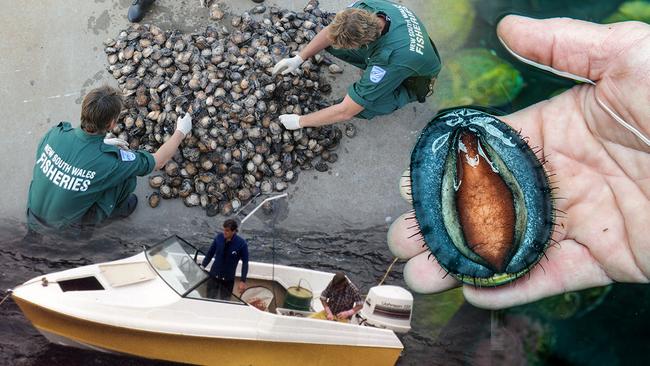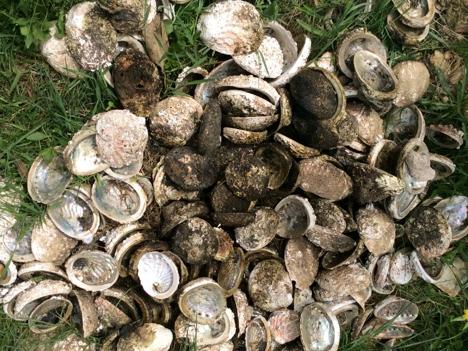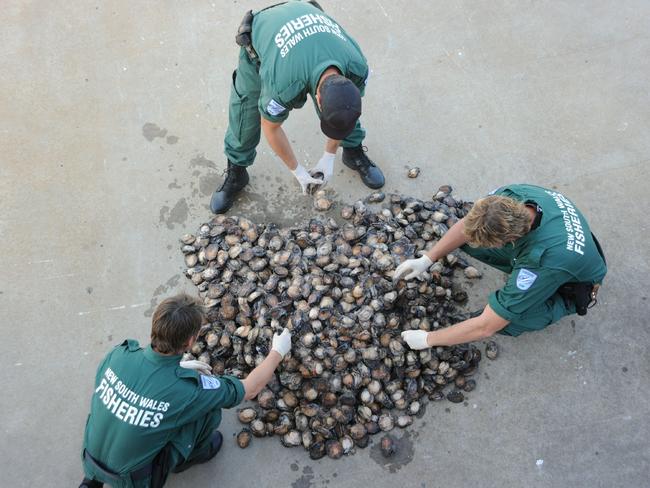Andrew Rule: How a broken system is set to wipe out a species
A flood of stolen abalone trafficked to organised crime outfits — with outlaw bikies riding shotgun — is being enabled by jittery prosecutors and politicians wary of volatile Indigenous politics.

Andrew Rule
Don't miss out on the headlines from Andrew Rule. Followed categories will be added to My News.
For fisheries officers, Mogo was no go. At least, not alone or without backup, preferably armed police to keep the peace if local abalone poachers were about.
They called them the Mogo Syndicate, a group of poachers related by blood and marriage who live around Batemans Bay on the south coast and have connections down the coast to Victoria, where they did the occasional poaching trip.
In the bush at Mogo, locals knew, the mob had a “factory”, a hidden shed where they dried and packed thousands of stolen abalone for a Chinese syndicate that pays cash.
To the satisfaction of fisheries officers and police, the big bushfires of 2020 burned down the not-so-secret Mogo shed. But that didn’t stop the supply chain.
There’s so much money in the coveted shellfish some call “cold gold” that black marketeers dive straight back into business after any setback. Not that they’ve had many setbacks in recent years.
Made bold by government apathy, the south coast poachers have ramped up abalone theft to a pitch that has already wiped out the fishery along nearly 200kms of the coast, and now threatens to wipe it out all the way to the border.
For them, stealing abalone is the perfect crime. They can pocket millions of dollars between them but not go to jail for it, facing an occasional fine paid in easy instalments, if at all.
Poachers, mostly linked to the Mogo crew, are stripping the fishery of 50 tonnes of undersized abalone a year for the same voracious black market that has destroyed abalone fisheries across the world.
Proof of this crime against nature — and fellow Australians — are the piles of shucked shells the thieves leave on shore when they don’t bother throwing them into the sea.

From small piles of a few dozen shells to big heaps holding more than a thousand, they have one thing in common: most of the shells are smaller than the legal limit of 117mm, the average size of seven-year-old blacklip abalone mature enough to have reproduced.
The poachers are plundering shellfish too young to breed, a sure way to wipe out any species. Licensed divers, by contrast, take only the biggest — about one in 10, which is sustainable forever.
Licensed divers and marine scientists say the poachers’ reckless vandalism is not just illegal but immoral, a sure way to guarantee there will be no abalone for anyone’s grandchildren, including descendants of poachers claiming to be above the law.
Stressed fishing industry insiders say that while the abalone is left unprotected, the predators are escaping virtually unpunished in NSW, where a legal loophole to allow traditional Indigenous fishing is exploited by crime syndicates with tentacles reaching from Australia into Asian markets.
A handful of opportunists are cynically abusing their right to “cultural fishing,” pillaging a natural resource that, once gone, will not return. The south coast poachers are one supply line for an insidious but almost invisible crime cartel.
Apart from robbing the wider community, the poachers are robbing their own — thousands of law-abiding Indigenous people who live along the coast between Wollongong and Victoria.
Frustrated fisheries officers and police trying to save abalone breeding grounds and angry licensed divers trying to save their livelihoods point to jittery prosecutors, politicians and bureaucrats so nervous of volatile Indigenous politics that they would rather endanger a species than defend conservation.
The result: a rising tide of stolen abalone trafficked to organised crime outfits, sometimes involving outlaw motorcycle gangs riding shotgun for poachers and receivers.
Of course, not every poacher on the coast is one of the Indigenous crew based around Batemans Bay. Outsiders sometimes pull a raid.

At one foray at Sussex Inlet near Jervis Bay in December 2022, outlaw bikies with attack dogs patrolled rock platforms to intimidate horrified locals while Asian divers ripped abalone off the bottom.
Other bikies parked a vehicle across the local fisheries office driveway to stop the officers responding to any calls, while a “stooge” went inside to distract officers with fake inquiries.
Motorcycle gangs aren’t the only criminals to infiltrate the abalone market. Locals say the poachers bring back drugs, weapons and stolen gear to the coastal towns after selling their illicit catch, harming their own community.
The main syndicate mostly uses teenagers from within certain family groups to do the diving, as courts rarely fine young people, let alone jail them. For the same reason, the syndicate uses the young divers’ girlfriends to drive cars loaded with abalone.
Watchers notice that the poachers have the latest and best diving gear — all new and the same brand.
“They are being sponsored by someone higher up the chain,” says one licensed diver. “Someone providing them with job lots of equipment.”
The official estimate of 50 tonnes “live weight” stolen annually is more than double what it was just three years ago. That 50 tonnes represents almost 17 tonnes of the prized meat, which sells illegally for $70 a kilogram or more — a total of $1.2m cash.
The real impact of theft on the fishery is twice what it appears, says veteran marine scientist Duncan Worthington, who has worked for both government and industry bodies to monitor abalone stocks.
The maths is simple: 50 tonnes of small abalone left to grow for another two years would turn into almost 100 tonnes.
In other words, thieves are effectively robbing the fishery of the same amount as the total legitimate catch. But, unlike licensed divers, by taking undersized shellfish they kill the breeding cycle.
It’s about cash, drugs and cars — not food. As one licensed diver told this reporter, snaring more than a million dollars a year “isn’t bad between a handful of poachers.”
The poachers have no overheads and pay no tax, so they can net more than licensed fishers who face huge bills for doing the right thing.

Poachers need only a pair of fins, a bag and an abalone tool — the blunt “knife” used to lever the shellfish from reefs.
By contrast, commercial divers (in NSW) pay a minimum $700,000 for their dive entitlement plus hefty annual licence fees, insurance and boats to harvest mature abalone in deeper water.
They also pay for refrigerated storage and transport to prevent the fish from deteriorating before it gets to a legal market, something the poachers don’t do, increasing the risk of contamination and ruining Australia’s image for producing clean, wild-caught seafood.
The syndicate that is systematically stripping the coastal reefs is moving south towards the border. The ominous shell piles now appear as far south as Bermagui and Eden.
This group has been illegally selling commercial quantities of abalone for many years under the guise of Indigenous cultural fishing but has ramped up the “take” in the last two years, confident of bluffing their way around the law.
Fisheries officers and police are willing to enforce laws but prosecutors are not, as if wary of provoking the belligerent Indigenous lobby and its media defenders.
The rules are simple but interpretation of them is not because the poachers cite “native title” as the answer to any challenge, a ploy that spooks naive Sydney-based authorities.
Any citizen can take home two abalone but Indigenous “cultural” fishers can take 10 each — and many more for a cultural event for Indigenous family and friends.
If they took only what they could eat, as intended under the “cultural fishing” provisions, it wouldn’t matter. But when divers go back into the water 10 times a day and take 100 abalone each, they are not eating them. They are trafficking them.
The rule against taking undersized abalone applies to everyone. But the “cultural” poachers are ignoring the minimum size rule as well as bag limits, unafraid of token consequences.
Selling trafficable quantities of more than 50 abalone is supposedly a serious offence punishable with jail but it rarely happens that way.

In the few cases allowed to reach court, defences based on “I’m just a poor boy trying to feed my family” prove amazingly successful.
The lack of deterrent is catastrophic for the environment. Unchecked poaching smashes the abalone breeding cycle, which triggers an explosion of sea urchins that destroys vital kelp beds. Next come swarms of starfish which strip the rock reefs of algae and weed.
This serial depredation results in what divers and marine scientists call “polished white rocks” — an underwater desert.
This has happened to abalone beds all over the world from Mexico to Japan but notoriously in South Africa, where Chinese triads have exploited poachers and corrupt officials to take an estimated 96 million abalone for the voracious Hong Kong market.
Abalone poaching is not new in Australia or New Zealand but it hasn’t threatened extinction of the coveted shellfish until now.
One of the world’s most infamous poachers, one-time Melbourne Grammar student Cam “The Captain” Strachan, served serious jail time in Victoria and was banned from Tasmania altogether after being arrested multiple times, usually after high-speed boat chases in Bass Strait.
Police and fisheries officers did not pull punches with Strachan and his fellow poachers on either side of the strait.
But in southern NSW, the war between authorities and recidivist poachers has become increasingly one-sided as black marketeers posing as bona fide Indigenous “cultural” fishers call the government’s bluff.
Licensed divers, legitimate processors and industry fishing bodies say the poachers have already destroyed the fishery from Ulladulla south to Bermagui. And the union representing fisheries officers is fighting for its members to have defensive equipment like handcuffs and batons to do their jobs safely.
“We have people who have been threatened with knives and shot at,” says union industrial manager Siobhan Callinan. Her colleague, industrial officer Shane Howes, says lack of consequences has bred “a level of brazenness” that heightens the risk of officers being abused, threatened and attacked.
There are plenty of examples of threatening behaviour but one ugly exchange with an accused poacher, John Junior Carriage, in the Murramarang National Park near Batemans Bay, shows why officers avoid working alone.
Carriage refused to give his name and address and when told he was committing an offence, he retorted: “I am not … I own this land, you white motherf--kers” then launched into a rant.
“F--k off you f--king piece of shit, f--king scumbags. Little scabs, that’s what youse are.”
Carriage was “minding” three young divers seen taking several times the bag limit of 10 abalone each, many of them undersized.
Around the same time, another well-known member of the Mogo syndicate was caught delivering 439 abalone to an illegal abalone processing factory in western Sydney where a total of 2870 abalone were seized along with 40kg of shark fins.
Sadly, experts say, that haul is just part of the huge number of stolen abalone channelled through Sydney from illicit divers all over southern Australia.
Earlier this year, police arrested seven unidentified people after an exhaustive investigation that included close surveillance and phone taps over almost a year. Some of the secret seven are believed to be Chinese and some not.
It will be interesting to see, if and when they go to court, if justice is colour blind.




